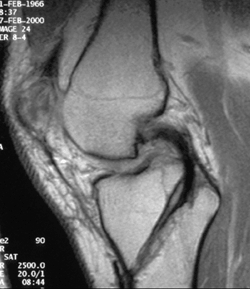Single-bundle posterior tibial inlay PCL repairs prove easier, more anatomic
Surgical reconstruction is indicated for patients with less than 10-mm posterior laxity and complete tears.
A surgeon who switched to doing PCL reconstructions with a posterior tibial inlay technique and Achilles tendons allografts recommended it over tibial tunnels because it is easier to perform and less prone to graft stretching and thinning.
At Orthopedics Today Hawaii 2010, John A. Bergfeld, MD, FACSM, said one reason he prefers the posterior tibial inlay surgical technique over others is it better reproduces the normal anatomy.
“Successful treatment depends on an accurate diagnosis. The physician exam is a keystone to the diagnosis,” he said.
Bergfeld reviewed the PCL anatomy at the meeting, noting athletes typically tear their PCLs when falling on a flexed knee. He discussed indications for nonoperative and operative repairs, managing complete ruptures and rehabilitation strategies.
Nonoperative care
|
|
Nonoperative care is effective for partial tears, said Bergfeld, the sports medicine section editor for the Orthopedics Today Editorial Board. “With an MRI that shows continuity of the ligament and meets the physical examination parameters outlined, I feel comfortable not operating,” he explained.
Bergfeld opts for nonoperative treatment in patients with abnormal, straight laxity less than 10 mm. This posterior laxity decreases when the tibia is internally rotated on the femur, and there is less than 5· abnormal rotary laxity and no significant varus or valgus laxity. He has had success treating these patients nonoperatively 85% to 90% of the time.
Primary repair
“The PCL is different than the ACL. It has a generous synovial envelope, an excellent blood supply and supporting structures … The potential for healing is great. I think people are beginning to show that,” Bergfeld said. Thus, primary PCL repairs can be more effective than primary ACL repairs, he noted.
To make his point, Bergfeld showed a case he treated successfully in which the femoral origin of the PCL was fixed with sutures placed in the acutely avulsed ligament tied over a bone bridge.
|
Image: Bergfeld JA |
MRI helpful
Bergfeld recommended using radiographs to find avulsed ligament bone insertion fragments that might need to be repaired. MRI can help establish continuity of the PCL, even with a partial tear. “It is 100% sensitive, accurate and specific,” he said.
MRI also shows full ligament disruption with complete ruptures. Performing a thorough examination on patients in whom a complete tear is suspected is critical, Bergfeld added: “If the patient has more than 10 mm posterior laxity and it does not tighten with internal rotation, that is a complete PCL injury and [it] needs surgical reconstruction.”
Support for inlays
For totally blown apart PCLs, Bergfeld prefers posterior tibial inlays to tunnels. The latter can create the “killer curve,” which may stretch the ligament graft and cause it to fail.
In a laboratory study he and colleagues conducted both techniques were comparable at the outset, but over time the tibial tunnel cases started failing. Researchers determined the inlay approach eliminated the “killer curve.” Markolf and colleagues reached the same conclusion in their study of 31 graft pairs implanted both ways and tested for 2,000 cycles.
Rehabilitation consists of keeping the knee immobilized in extension for 4 weeks, allowing partial/total weight-bearing as tolerated while doing isometric quadriceps exercises At 4 weeks postoperative, patients do assisted active range of motion work for 4 weeks with the knee in a brace blocked at -15° of extension. They progress to a closed-chain routine and can return to play in about 8 to 9 months, Bergfeld said. – by Susan M. Rapp
References:
- Bergfeld JA, Graham SM, Parker RD, et al. A biomechanical comparison of posterior cruciate ligament reconstructions using single- and double-bundle tibial inlay techniques. Am J Sports Med. 2005;33(7):976-981.
- Bergfeld JA, McAllister D. Biomechanical comparison of posterior cruciate ligament reconstruction techniques. Am J Sports Med. 2001;29(2):129-136.
- Bergfeld JA. Why and how I use an inlay: PCL reconstruction. Presented at Orthopedics Today Hawaii 2010. Jan. 10-13, 2010. Kohala Coast, Hawaii.
- Markolf K, Zemanovic JR, McAllister DR. Cyclic loading of posterior cruciate ligament replacements fixed with tibial tunnel and tibial inlay methods. J Bone Joint Surg (Am). 2002; 84(4):518-524.
- John A. Bergfeld, MD, FACSM, is medical director of the Cleveland Clinic Sports Medicine Program. He can be reached at Cleveland Clinic Sports Health, 9500 Euclid Ave., A-41, Cleveland OH 44195; 216-444-2618; e-mail: bergfej@ccf.org.
![]()
In our experience with ligament reconstruction, we have come to appreciate the anatomy of the cruciate ligaments now more than ever before. The application of surgical techniques that favor restoring the native anatomy should be the focus of cruciate reconstruction, as it is believed that this best restores native biomechanics of the knee. Dr. Bergfeld believes that the tibial inlay better restores the anatomy of the posterior cruciate ligament (PCL). However, tibial tunnel PCL reconstruction, if done correctly, is also capable of restoring the anatomic femoral and tibial insertions of the PCL. As mentioned by Dr. Bergfeld, the “killer curve” is a potential disadvantage of the tibial tunnel technique. Disadvantages of the tibial inlay technique include the more extensive dissection required and the decreased surface area of graft to host contact. In our experience, there have been good results with both single- and double-bundle PCL reconstruction using the tibial tunnel technique. However, more important than small details in operative technique is careful attention to restoration of the native anatomic insertion sites of the ligament and adoption of a technique that allows for an anatomical reconstruction that the surgeon feels comfortable performing.
– Freddie H. Fu, MD, DSc(Hon), DPs(Hon)
University of Pittsburgh Medical Center


